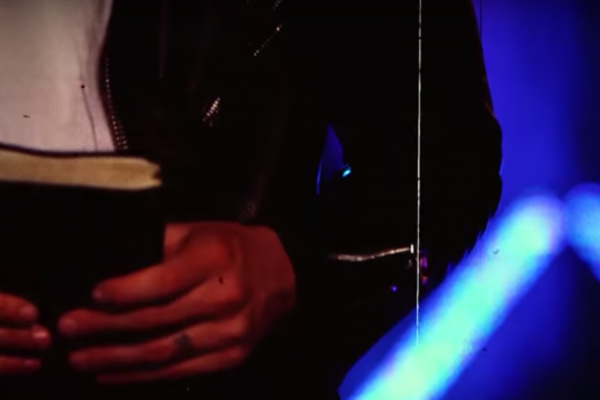Rich Wilkerson Jr. is no ordinary pastor. He rose to fame as the pastor who officiated the wedding of Kanye West and Kim Kardashian in 2014. Because of his good looks and famous friends, Wilkerson was dubbed by entertainment news outlets as the “hottest holy man around.”
In his new reality show Rich in Faith, Rich Wilkerson Jr. tells his fellow pastor, current boss, and father Rich that he’s planning a worship service at a venue called The Stage, a trendy local bar — that yes, has a liquor license. In this clash of generations, Wilkerson Sr. is shocked that his son would lead a worship service in place marked by the trappings of “moral debauchery.” He questions the decision, then jokes about it, but ultimately agrees to come see the first service.
Rich in Faith, which debuted in December on Oxygen Network, tells the story of Wilkerson Jr. and wife DawnChere as they start a church plant in downtown Miami, Fla. Following the rise of Wilkerson’s status of “celebrity pastor,” this show frames the story of Wilkerson as butting up against the establishment, the tradition and order of Christianity, all manifested in the megachurch his father planted. Based on this interaction alone, Wilkerson Jr. is a rebel, a visionary, and mapping “new” ways of practicing Christianity.
In a press release from August 2015, Oxygen Network announced that, “Rich is smashing stereotypes about religion with his successful young adult ministry,” and the couple is “eager to share their innovative and thought-provoking ministry.”
But despite the narrative of being different than “old” Christianity, hipster Christianity and the “celebrity” pastors that lead it are not the first to find themselves in the intersection of fame, Christianity, and new media.
Within the last sixty years, numerous pastors have used new forms of media — beginning with television — to reach thousands of people eager for their message. Pat Robertson founded the Christian Broadcasting Network, which continues to appeal to millions of people around the world. Joel Osteen’s ministry is broadcasted into every U.S. television market. And Billy Graham, arguably one of the most famous evangelical pastors, started radio and television programs, as well as numerous books, a magazine, and a syndicated newspaper column. Before hipster Christianity was on Instagram, these televangelists utilized methods of evangelizing considered new and strange.
And looking even further back — specifically, New York during the 19th century — I found a prototype of hipster Christian pastors in Charles Finney. Finney shook up American Christianity during the Second Great Awakening with emotional preaching and an evangelical fervor that led thousands of people to convert to Christianity. Finney rubbed against “traditional” forms of Christianity and practiced innovative forms of worship — sometimes holding worship in the forest rather than in pews.
Charles Finney may not have been preaching in a bar or posting to Instagram like today’s pastors, but he is remarkably similar to the “new” hipster pastors nonetheless. Like Wilkerson Jr., Finney had a commanding presence that one historian stated “had a mesmerizing effect on listeners.” Finney’s influence on American Christianity and evangelical pastors is widely documented. A clear line from Finney to Graham to Wilkerson Jr. can be drawn.
Rich Wilkerson Jr. and others like him, are not necessarily doing a new thing. Yes, their medium is new, and yes, their venue may be new, but the tension that arises between younger and older generations is not unique to their time. Calling hipster Christianity and its cohorts entirely unique chooses to ignore the long history of Christianity that has continually evolved and changed with time and culture.
Instead of being innovative, hipster Christianity and its portrayal in Rich in Faith feels like more of the same — the same as televangelists that used new media to spread their message of prosperity, the same faces of young white men who get lifted up as the singular voices of generations. From Rich Wilkerson Jr. in Miami to Chad Veach in Los Angeles and Carl Lentz in New York, hipster Christian pastors, who are gaining massive followings like their televangelists ancestors, all have similar messages — and similar looks.
In framing Rich in Faith as “new and innovative,” the show denies not only the historical foundation that led to its arrival, but also removes the diversity of voices that exist within Christianity. Trendy evangelical worship led by cool young white men does not begin to touch the breadth of diverse practices in the Christian world, nor does it lift up voices of those who do not fit our current mold of what a pastor looks like.
The people featured in Rich in Faith are not all white, nor all male, but that does not make up for the larger issue of white men being the centerpiece of this “new” Christianity. If hipster Christianity, as its branded, is for anyone seeking a relationship with Christ, why do the people popping up on reality TV, getting book deals, and being called the new face of Christianity all look the same? What exactly is new or different about that?
Rich in Faith is meant to be easily digestible and entertaining. It is a reality TV show, after all. It focuses on things we can relate to on some level: family dynamics, work-life balance, growing up. But it is all done through the lens of one good-looking charismatic person. By calling itself new and innovative, the show ignores the way its story, as well as the phenomenon it represents, is not so different from the white-washed, male-dominated world we live in.
Got something to say about what you're reading? We value your feedback!

